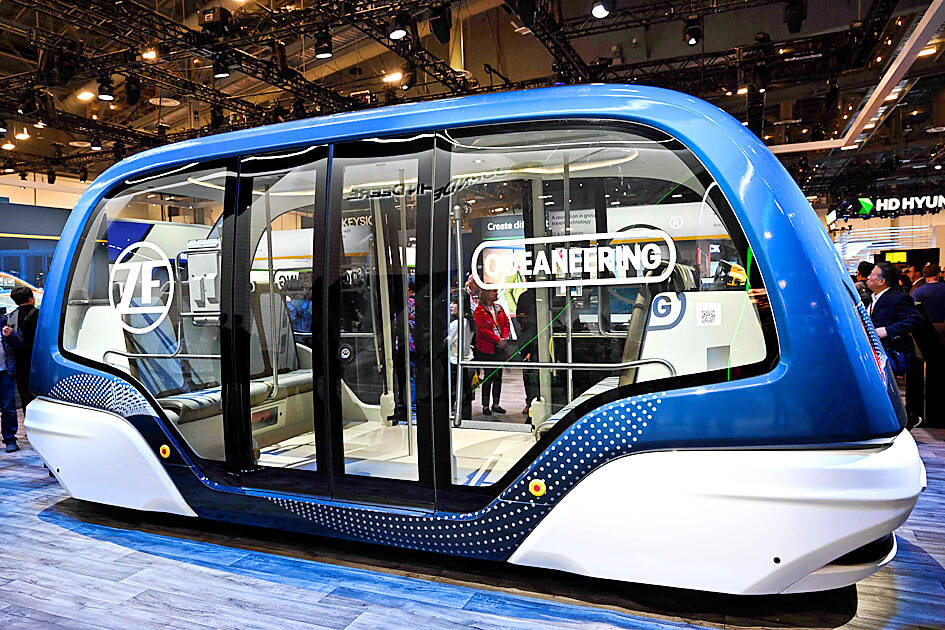Auto supplier ZF Friedrichshafen AG and Wolfspeed Inc plan to build a US$3 billion wafer factory in Germany’s Saarland to make chips for electric vehicles and other applications, a boon for a region dependent on combustion-engine components, according to people familiar with the matter
The go-ahead for the project is subject to commitments on subsidies amounting to a quarter of the total investment, the people said, declining to be named discussing private information.
ZF would hold a minority share in the factory with its US chipmaking partner, located in Ensdorf near Saarbrucken. ZF operates its largest factory nearby, where 9,000 employees make transmissions.

Photo: AFP
The plan would see the site of a former coal-fired power plant converted into the world’s largest factory for silicon carbide semiconductors, used in electric vehicles and photovoltaic converters. The move would create hundreds of jobs, the people said, providing relief over concerns for Saarland state’s 40,000 auto industry workers, where many toil to make combustion engine parts.
ZF and Wolfspeed hope to get a final decision on subsidies within the next couple of months, the people said.
The partners plan to start production of semiconductors in 2027 and reach full capacity by 2030. Spokespeople for ZF and Wolfspeed declined to comment on the plans. Handelsblatt earlier reported some details of the project.
The wafer fab in Saarland will help the EU in its ambitious goal of producing 20 percent of the world’s chips by 2030.
Germany’s progress luring international chipmakers has become tougher because of high energy prices and the pull of generous US subsidies under the Inflation Reduction Act. US chipmaker Intel Corp has recently delayed the construction start of its 17 billion (US$18.5 billion) semiconductor factory in Magdeburg. The company is in talks for more government subsidies to offset higher costs.
The type of chips Wolfspeed plans to make can boost the range of electric vehicles by as much as 15 percent with faster charging compared to conventional silicon chips. In addition to the factory, ZF and Wolfspeed plan to set up a R&D center in Germany, where ZF is to be the majority owner, the people said. The center would research applications of the chips in power inverters for electric ships or wind turbines.

SEMICONDUCTORS: The firm has already completed one fab, which is to begin mass producing 2-nanomater chips next year, while two others are under construction Taiwan Semiconductor Manufacturing Co (TSMC, 台積電), the world’s largest contract chipmaker, plans to begin construction of its fourth and fifth wafer fabs in Kaohsiung next year, targeting the development of high-end processes. The two facilities — P4 and P5 — are part of TSMC’s production expansion program, which aims to build five fabs in Kaohsiung. TSMC facility division vice president Arthur Chuang (莊子壽) on Thursday said that the five facilities are expected to create 8,000 jobs. To respond to the fast-changing global semiconductor industry and escalating international competition, TSMC said it has to keep growing by expanding its production footprints. The P4 and P5

DOWNFALL: The Singapore-based oil magnate Lim Oon Kuin was accused of hiding US$800 million in losses and leaving 20 banks with substantial liabilities Former tycoon Lim Oon Kuin (林恩強) has been declared bankrupt in Singapore, following the collapse of his oil trading empire. The name of the founder of Hin Leong Trading Pte Ltd (興隆貿易) and his children Lim Huey Ching (林慧清) and Lim Chee Meng (林志朋) were listed as having been issued a bankruptcy order on Dec. 19, the government gazette showed. The younger Lims were directors at the company. Leow Quek Shiong and Seah Roh Lin of BDO Advisory Pte Ltd are the trustees, according to the gazette. At its peak, Hin Leong traded a range of oil products, made lubricants and operated loading

Citigroup Inc and Bank of America Corp said they are leaving a global climate-banking group, becoming the latest Wall Street lenders to exit the coalition in the past month. In a statement, Citigroup said while it remains committed to achieving net zero emissions, it is exiting the Net-Zero Banking Alliance (NZBA). Bank of America said separately on Tuesday that it is also leaving NZBA, adding that it would continue to work with clients on reducing greenhouse gas emissions. The banks’ departure from NZBA follows Goldman Sachs Group Inc and Wells Fargo & Co. The largest US financial institutions are under increasing pressure

TRENDS: The bitcoin rally sparked by US president-elect Donald Trump’s victory has slowed down, partly due to outflows from exchange-traded funds for the token Gold is heading for one of its biggest annual gains this century, with a 27 percent advance that has been fueled by US monetary easing, sustained geopolitical risks and a wave of purchases by central banks. While bullion has ticked lower since US president-elect Donald Trump’s sweeping victory in last month’s election, its gains this year still outstrip most other commodities. Base metals have had a mixed year, while iron ore has tumbled, and lithium’s woes have deepened. The varied performances highlight the absence of a single, over-riding driver that has steered the complex’s fortunes, while also putting the spotlight